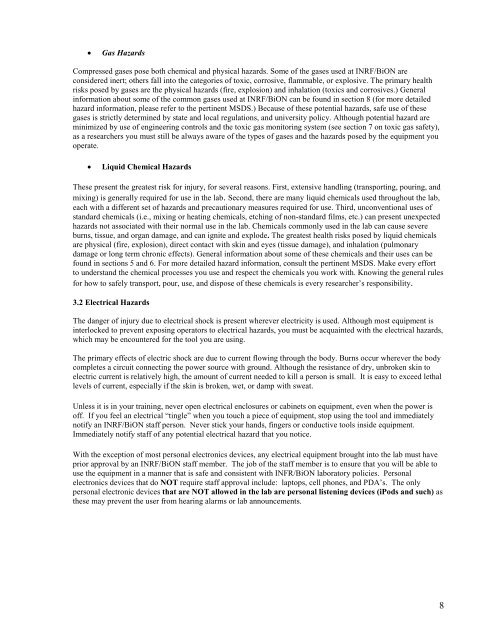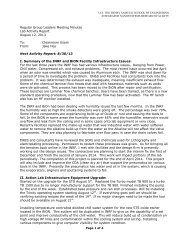Download Lab Safety Manual - Integrated Nanosystems Research ...
Download Lab Safety Manual - Integrated Nanosystems Research ...
Download Lab Safety Manual - Integrated Nanosystems Research ...
You also want an ePaper? Increase the reach of your titles
YUMPU automatically turns print PDFs into web optimized ePapers that Google loves.
• Gas Hazards<br />
Compressed gases pose both chemical and physical hazards. Some of the gases used at INRF/BiON are<br />
considered inert; others fall into the categories of toxic, corrosive, flammable, or explosive. The primary health<br />
risks posed by gases are the physical hazards (fire, explosion) and inhalation (toxics and corrosives.) General<br />
information about some of the common gases used at INRF/BiON can be found in section 8 (for more detailed<br />
hazard information, please refer to the pertinent MSDS.) Because of these potential hazards, safe use of these<br />
gases is strictly determined by state and local regulations, and university policy. Although potential hazard are<br />
minimized by use of engineering controls and the toxic gas monitoring system (see section 7 on toxic gas safety),<br />
as a researchers you must still be always aware of the types of gases and the hazards posed by the equipment you<br />
operate.<br />
• Liquid Chemical Hazards<br />
These present the greatest risk for injury, for several reasons. First, extensive handling (transporting, pouring, and<br />
mixing) is generally required for use in the lab. Second, there are many liquid chemicals used throughout the lab,<br />
each with a different set of hazards and precautionary measures required for use. Third, unconventional uses of<br />
standard chemicals (i.e., mixing or heating chemicals, etching of non-standard films, etc.) can present unexpected<br />
hazards not associated with their normal use in the lab. Chemicals commonly used in the lab can cause severe<br />
burns, tissue, and organ damage, and can ignite and explode. The greatest health risks posed by liquid chemicals<br />
are physical (fire, explosion), direct contact with skin and eyes (tissue damage), and inhalation (pulmonary<br />
damage or long term chronic effects). General information about some of these chemicals and their uses can be<br />
found in sections 5 and 6. For more detailed hazard information, consult the pertinent MSDS. Make every effort<br />
to understand the chemical processes you use and respect the chemicals you work with. Knowing the general rules<br />
for how to safely transport, pour, use, and dispose of these chemicals is every researcher’s responsibility.<br />
3.2 Electrical Hazards<br />
The danger of injury due to electrical shock is present wherever electricity is used. Although most equipment is<br />
interlocked to prevent exposing operators to electrical hazards, you must be acquainted with the electrical hazards,<br />
which may be encountered for the tool you are using.<br />
The primary effects of electric shock are due to current flowing through the body. Burns occur wherever the body<br />
completes a circuit connecting the power source with ground. Although the resistance of dry, unbroken skin to<br />
electric current is relatively high, the amount of current needed to kill a person is small. It is easy to exceed lethal<br />
levels of current, especially if the skin is broken, wet, or damp with sweat.<br />
Unless it is in your training, never open electrical enclosures or cabinets on equipment, even when the power is<br />
off. If you feel an electrical “tingle” when you touch a piece of equipment, stop using the tool and immediately<br />
notify an INRF/BiON staff person. Never stick your hands, fingers or conductive tools inside equipment.<br />
Immediately notify staff of any potential electrical hazard that you notice.<br />
With the exception of most personal electronics devices, any electrical equipment brought into the lab must have<br />
prior approval by an INRF/BiON staff member. The job of the staff member is to ensure that you will be able to<br />
use the equipment in a manner that is safe and consistent with INFR/BiON laboratory policies. Personal<br />
electronics devices that do NOT require staff approval include: laptops, cell phones, and PDA’s. The only<br />
personal electronic devices that are NOT allowed in the lab are personal listening devices (iPods and such) as<br />
these may prevent the user from hearing alarms or lab announcements.<br />
8



